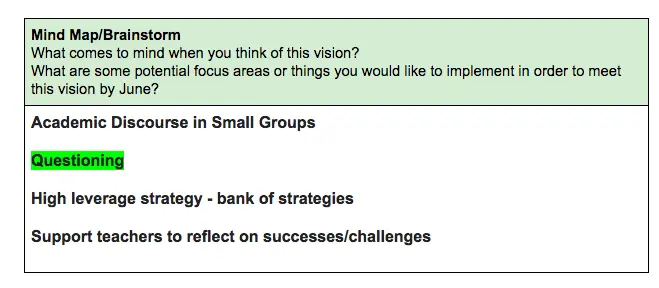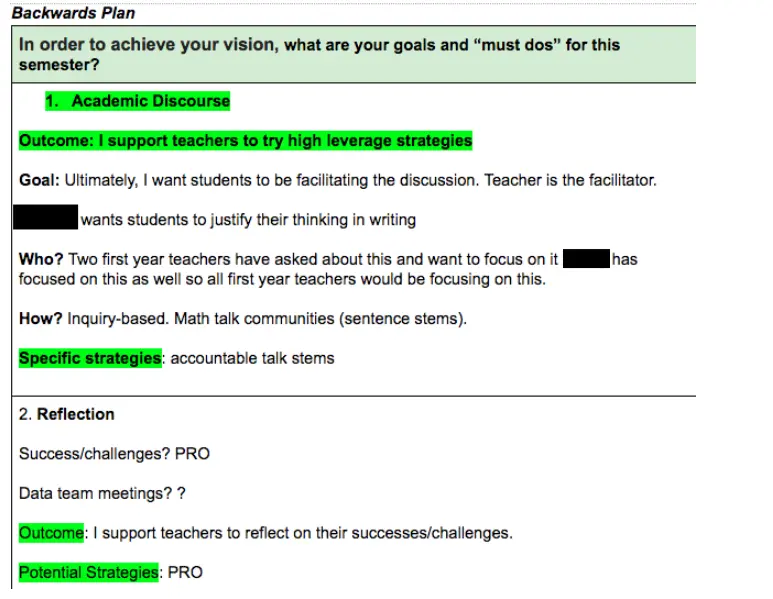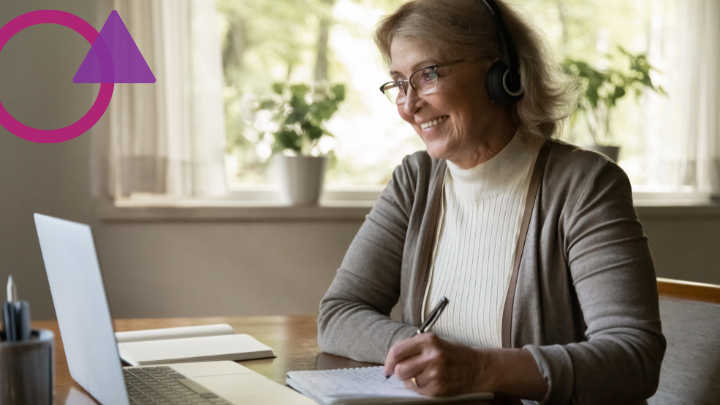Do you feel like your teachers are losing momentum as the year winds down? As instructional coaches, we start the year supporting our teachers to create meaningful goals, excited about the countless opportunities that lie ahead. But, as the year progresses and the demands increase, it can begin to feel difficult for you, and your teachers, to keep those goals at the forefront. We still want to support our teachers to accomplish those goals, but what should we do when we lose momentum or a shared purpose? Even if we are right on track, I have found that it can be very helpful to revisit our goals and reflect on what we have accomplished, and refocus on what steps we still need to take.
Re-visiting our initial goals is exactly what I did with Sarah Neff. Sarah is an instructional coach in Groton, New York who I have been coaching this year. In September, Sarah set her vision for the year. Sarah wanted to focus on supporting teachers to feel comfortable with her coaching, ensuring her coaching was productive to her teachers, and supporting teachers to implement high leverage strategies that helped students to build conceptual understanding in math while students did “the heavy lifting.” As it often happens, new demands and challenges arise as the year progresses, which left us working within Sarah’s focus areas and outside them. When we resumed coaching after December break, Sarah and I used backwards planning to ensure that despite new demands, we mapped out had concrete steps to meet her goal. This ensured that even if we focused on new challenges, which we often have, Sarah’s vision and goals were again at the forefront of our work.

Backwards Planning: How It Works
As educators, we have been trained to use Backwards Planning to construct units. We keep the goals of the unit (the end) in mind, as we construct the path to reach those goals. Backwards planning is essential during unit planning, but I have found that this can be an equally important strategy for coaching. Implementing backwards planning as a strategy for coaching has been transformative in our work with teachers at BetterLesson. It provides teachers with another opportunity to think big picture, to revive their excitement about their initial goals, and provides a plan with specific steps to support them as they work towards their goals.
Below are four steps I have taken to implement backwards planning with the teachers and coaches I support as the year winds down. Using Sarah’s experience as an example. I will share what we did together during each step.
Step 1: Review Goals
At the start of the year, BetterLesson participants create a vision. Their vision serves as the North Star of our work; it is embedded within every decision we make, and is the goal we are ultimately working towards.
When I decided to try backwards planning in my coaching, I knew the first step was to have participants review their vision. It enabled teachers to zoom out to see the big picture. It provided us with an opportunity to celebrate what the teachers had already accomplished and helped us to determine the steps we still needed to take to reach our goal.
Sarah’s Vision:
I want my teachers to teach math utilizing questions that prompt students to discover the processes that work to solve a problem and make meaning out of the math for themselves (heavy lifting). I want to coach them in a way that makes them feel comfortable and confident taking the risks to shift to that “style” of teaching. I want to be confident enough in my coaching to suggest these shifts.
When Sarah and I reviewed her vision in January, she and I celebrated all that she had achieved. In addition, we realized it would be beneficial to continue focusing on high leverage strategies that would support students “to discover the processes that work to solve a problem and make meaning out of the math for themselves (heavy lifting).”
Step 2: Backwards Plan
The next step is for teachers to backwards plan from their goal to the current reality in their classrooms, and identify focus areas.
During the backwards planning process, we identified big focus areas, such as feedback or academic discourse, that would support the teacher to reach her vision. While the loftiness of the steps may vary from teacher to teacher, the process of backwards planning is the same.
Sarah and I discussed the challenges in her work, and she shared that some students still needed support developing their conceptual understanding of math and that teachers needed support to help students to do the heavy lifting. Identifying what was currently happening helped us determine an area of which focus, which was supporting teachers to implement high leverage strategies, and providing teachers with focused, actionable feedback. Sarah was excited to continue narrowing in these outcomes in order to best support her teachers!

I believe this is the step that has been most transformative in my coaching. This step creates a space for teachers to think about how their goals can come to life within their classroom walls. It requires teachers to think about what the goal looks like and sounds like in their classroom in order to identify meaningful and productive steps in the plan.
I am continually inspired by how powerful these conversations are, and the excitement that ignites in teachers when discussing these steps.
Step 3: Actionable Strategies
Since many of my teachers identified bigger focus areas during step two, we used step three to narrow our focus to specific strategies or activities within each of our backwards planning steps. This step was crucial for making the plan actionable. For example, Sarah wanted to focus on supporting teachers to increase the academic discourse in the classroom. Since students were often sharing out their answers but not discussing, we decided that the strategy, Accountable Talk Stems, would be a good starting point for increasing discourse in the classroom. Often teachers want to accomplish a goal, but aren’t sure where to start. This step was the motor to move towards our goal.
Examples of Accountable Talk Stems
I kindly disagree with you because…
Can you explain how…
I wonder…
I noticed that…
Your strategy reminds me of…
That makes sense because…
How did you…
Step 4: Implementation & Reflection
The final step in this process is reflection. Once teachers implement strategies or activities from their plan, it is important to provide a space for reflection. Teachers reflect on what went well, and what didn’t go as planned. Did implementing the plan support progress towards their bigger goal? Based on these learnings, we determine the best next step to continue working towards our goal.
When Sarah and I reflected on her work, we realized the power in backwards planning and fast cycle learning. The backwards plan helped keep Sarah’s goal at the forefront of our work, and Sarah’s individual reflections fueled next step within each focus area. For example, when reflecting on the implementation of Accountable Talk Stems, Sarah noticed the need for additional practice and scaffolding in one class. Therefore, during the next iteration, we implemented a fishbowl model for students to see the strategy in action again.
Backwards planning has been a transformative strategy in my coaching practice. This strategy has inspired teachers to continue working towards their goal despite the challenges and distractions this time of year.
Backwards planning was not only transformative for me, but it was also transformative for Sarah. When asked if this felt like a useful activity, Sarah shared, “I think this was really great. It’s really helpful to keep the end in mind. It helps to keep our vision in mind. We are definitely working on a ton of different things and I think it is easy to get caught up in little things you want to fix . But overall, just like in school district, if you don’t have your vision in mind it’s easy to go astray.” Since completing our backwards plan, Sarah has made incredible progress toward her vision and has a step-by-step plan to fall back on as she finishes up her school year.







